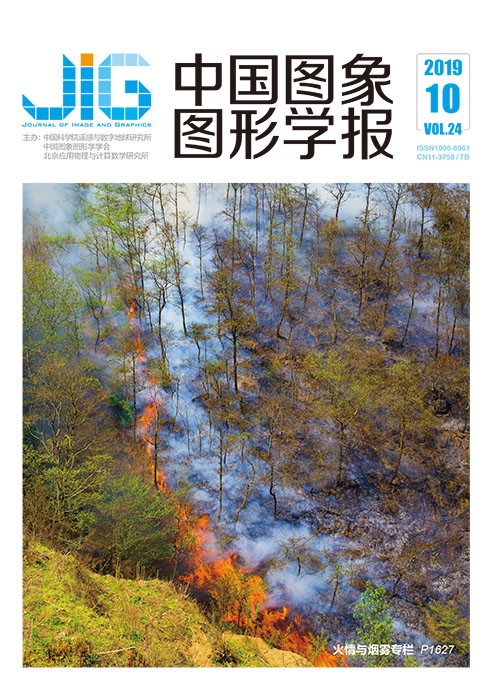
自然光照条件下植被几何光学四分量的提取算法
摘 要
目的 几何光学四分量是指在太阳光照条件下传感器所能观测的4个光学分量,即光照植被、光照土壤、阴影植被和阴影土壤。四分量是构成遥感几何光学模型的重要内容。在近地表遥感应用中,相机俯视拍照是提取四分量的一个途径。准确快速地从图像数据中提取四分量对植被冠层结构参数反演和植被长势监测具有重要意义。方法 植被与土壤二分量的识别是四分量提取的基础。目前大多数二分类算法在自然光照条件复杂时分类误差较大。本文基于卷积神经网络(CNN)和阈值法实现了多种二分类和四分量提取算法。阈值法中,使用SHAR-LABFVC (shadow-resistant algorithm:LABFVC)实现植被与土壤的二分类,并在此基础上应用二次阈值分割获取四分量,称为二次阈值法;基于CNN的方法中,采用U-Net架构,并使用RGB和RGBV数据进行训练得到U-Net和U-Net-V模型,前者完成二分类和四分量任务,后者只完成四分量提取实验。最后,对一种结合U-Net与阈值法的混合算法进行四分量提取实验。结果 本文在18幅图像(1 800个子图)数据上进行了实验,结果表明,与目视解译得到的四分量真值相比较,U-Net-V和混合法精度最高,具有相近的均方根误差(RMSE)(0.06和0.07)和相关系数(0.95和0.94);二次阈值法与U-Net模型精度略低于上述两种算法,RMSE分别是0.08和0.09,相关系数均为0.88。在二分类实验中,U-Net的分类正确率是91%,SHAR-LABFVC为85%。结论 通过对比实验表明,在二分类问题中,U-Net可以更好地应对复杂自然光照条件下的数字图像。在四分量提取实验中,混合法和U-Net-V的结果优于U-Net与二次阈值法,可以用于提取四分量。
关键词
Algorithm for classifying four geometric-optical components from images in natural illumination conditions
Gao Zebin1,2, Qu Yonghua1,2(1.State Key Laboratory of Remote Sensing Science, Beijing 100875, China;2.Beijing Engineering Research Center for Global Land Remote Sensing Products, Institute of Remote Sensing Science and Engineering, Faculty of Geographical Science, Beijing Normal University, Beijing 100875, China) Abstract
Objective The four components of a geometric-optical model, i.e., lit vegetation, lit soil, shaded vegetation, and shaded soil, could be observed by optical sensors in nature light condition. The four components are the important parameters of the geometric-optical model. Images obtained from a downward-looking canopy digital camera serve as an important source to derive the four components. A rapid and accurate method for extracting the four components for canopy parameter inversion, including the leaf area index and average leaf inclination angle, is proposed. However, most of the algorithms only distinguish the vegetation and soil (i.e., two-class task) pixels, and the classification error is large under the condition of complex natural light. The main error is produced by specular reflection pixels, which are nearly white in the image, and shadow-canopy pixels, which are nearly black in the image. With the rapid development of deep learning, the accuracy of image semantic segmentation, that is, the classification of pixels is improved significantly. Therefore, the error introduced by specular reflection pixels and shadow canopy pixels may be reduced. Method Several two-class and four-component extraction algorithms are implemented on the basis of the convolutional neural network and threshold method. In the proposed methods, SHAR-LABFVC is a threshold method, and it is used to fulfill two-class classification. When an image is captured in a direct light condition, the V channel data from the HSV color model present a double-peak feature in histogram. Thus, on the basis of the result of SHAR-LABFVC, the Otsu method is applied to the V channel data to classify the four components. Thus, the two-stepwise procedure is referred to as the double-threshold algorithm. Another algorithm is the U-Net, which is a neural network-based method and is used to extract the two-class and four-component algorithms. We obtain two models based on U-Net. One is trained using RGB image data, which is referred as U-Net, and another is trained using RGB-V image data, which is referred to as U-Net-V. RGB-V data are images, which combine RGB and V channel data of HSV. Finally, to fully use the advantages of the supervised and unsupervised algorithms, a hybrid method, which combines U-Net and the threshold method, is proposed and used to classify the four components, similar to that done in the double-threshold algorithm. We use U-Net to obtain vegetation and soil pixels. Then, the Otsu algorithm is used to acquire four components. Result The validation experiment is conducted using 18 images (1 800 subgraphs), and the performance is evaluated using two metrics, i.e., root mean square error (RMSE) and Pearson's r (r). Results show that U-Net-V and hybrid are optimal and that they have close RMSE values (0.06 and 0.07) and r (0.95 and 0.94); U-Net and the double-threshold method have close RMSE values (0.09 and 0.08) and the same r (0.88). In the two-class experiment, the classification accuracy of U-Net is 91%, and that of SHAR-LABFVC is 85%. For the two-class experiment, we use F1 score to evaluate the result of U-Net and SHAR-LABFVC. The vegetation's F1 score of U-Net is 0.87, which is 0.07 higher than that of SHAR-LABFVC. The soil's F1 score of U-Net is 0.92, which is 0.03 higher than that of SHAR-LABFVC. Conclusion The comparative experiments indicate that U-Net is superior to other methods in terms of dealing with digital images under complex natural light conditions in a two-class task. Compared with the SHAR-LABFVC method, U-Net can classify specular reflection pixels effectively and produce more stable and accurate classification results. The effective performance of U-Net in the two-class task is attributed to the convolution structure, which can utilize information from local image data and construct complex features by simple features. On the contrary, threshold methods only use one threshold to classify all pixels. The error will be high when some pixels disturb the distribution of the histogram. In the four-component extraction task, the hybrid algorithm has better result than U-Net and double-threshold method given the excellent performance of U-Net in the two-class task, whereas U-Net-V can produce the best results. U-Net can achieve an excellent performance by adding V channel data to raw RGB images. We summarize the RGB values of pixels and find that shadow leaf maybe close to sun lit leaf in a 3D space. Combined with the result of the confusion matrix, the shadow features are difficult to learn in our data set. Thus, we use RGB-V data to reduce the difficulty of learning shadow features and obtain the U-Net-V model. We suggest that the double-threshold method is the best candidate method to extract the four components under the condition that training samples are unavailable. For the case in which sufficient training samples are available, using the U-Net-V method to extract the four components is recommended.
Keywords
four component of geometric-optical model convolutional neural network (CNN) threshold method canopy image processing semantic segmentation
|



 中国图象图形学报 │ 京ICP备05080539号-4 │ 本系统由
中国图象图形学报 │ 京ICP备05080539号-4 │ 本系统由